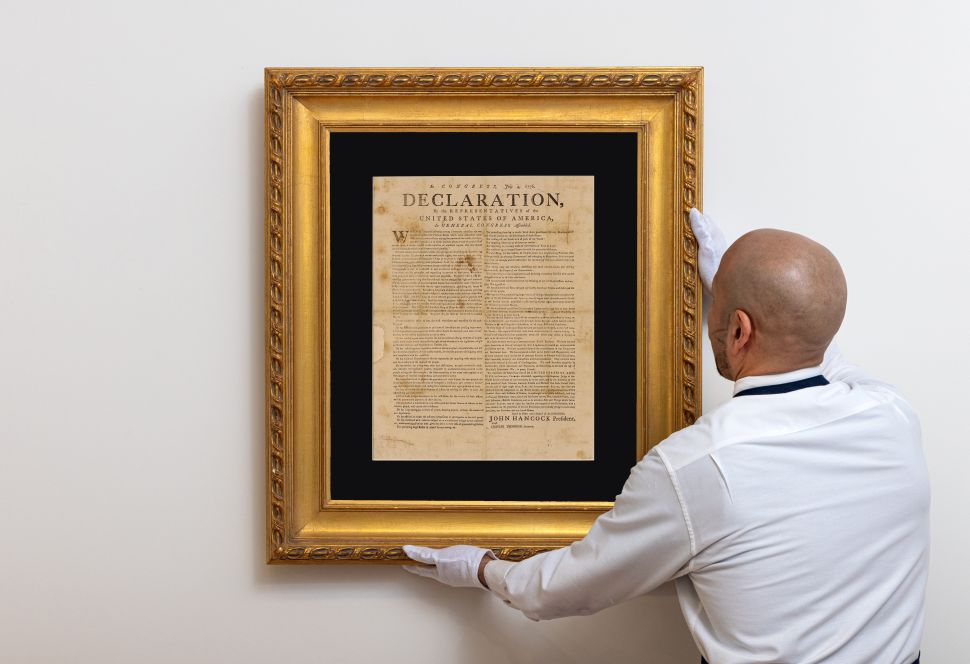Later this month, Sotheby’s will auction off a rare piece of American history: a 1776 printing of the Declaration of Independence. Scheduled to hit the block in a standalone live sale, The Declaration of Independence: The July 1776 Essex Broadside, on January 24, this remarkable artifact (estimate: $2-4 million) is one of just thirteen broadsides issued in 1776. Of these, only ten examples are known to survive, most of which are now tucked away in prestigious institutional collections.
“This rare printing of the Declaration of Independence is a cornerstone of American history, offering a glimpse into the transformative moment when the United States declared its independence,” said Kalika Sands, Sotheby’s Head of Books and Manuscripts, Americas, in a statement. “The Essex broadside, one of the earliest versions to reach the public, not only captures the bold spirit of a nation in its infancy but also stands as a timeless emblem of American heritage.”
The story behind the document is no less dramatic than the text itself. On June 7, 1776, Richard Henry Lee introduced a resolution declaring the colonies free and independent states, sparking heated debate and prompting the Continental Congress to appoint a five-man committee—Thomas Jefferson, John Adams, Benjamin Franklin, Roger Sherman and Robert R. Livingston—to draft a declaration of independence. Three days of intense deliberation culminated in its finalization on the evening of July 4, 1776. The original manuscript was then entrusted to John Dunlap, Congress’s official printer, who rushed to produce broadside prints for distribution across the thirteen colonies. Local printers, in turn, issued their own editions, including The Essex Broadside, attributed to Robert Luist Fowle of New Hampshire.
SEE ALSO: Rare Medical Books From the Collection of Eugene S. Flamm Are Coming to Christie’s
The July 1776 Essex Broadside stands out for its distinctive two-column format, reminiscent of biblical texts, and its incorporation of italic type while retaining the original headline from Dunlap’s broadside. The haste of the moment led to some typographical quirks: John Hancock’s name was initially misspelled but promptly corrected, while Charles Thomson’s surname retained an unintended extraneous “p.”
This historical treasure arrives at auction with an equally interesting provenance. First sold at Sotheby’s in 1967 as part of Thomas W. Streeter’s legendary Americana collection, it reappeared in 1978, consigned by Chicago collectors Philip and Elsie Sang. Both collections were rooted in a profound fascination with American history, particularly the Revolutionary War and the Declaration’s signers.
The auction comes at a particularly charged moment in American history, one in which The Essex Broadside feels like a particularly poignant artifact—one that serves as a reminder of the founding liberal principles that underpin the United States. Its sale also comes at a time when the market for manuscripts and founding documents is experiencing a dynamic surge. Sotheby’s set a landmark record when a Dunlap printing of the Declaration of Independence sold for $8.1 million. This milestone was eclipsed in November of 2021 with the sale of the first printing of the Constitution, which achieved $43.2 million—the highest price ever fetched for a historical document. That copy now resides at the Crystal Bridges Museum. More recently, in early 2022, another printing of the Constitution commanded $11.3 million, cementing the robust demand for America’s foundational texts.
The sale is part of Sotheby’s week-long celebration, Visions of America, a series of auctions, exhibitions and immersive experiences organized in partnership with automaker Cadillac. Highlighting the breadth of American artistry and craftsmanship, the series also includes a sale of literary treasures, Great Writers/Great Drinkers, and another dedicated to the finest American whiskeys. Among the standout lots is an Old Rip Van Winkle 25-Year-Old Decanter from 1989, carrying an estimate of $20,000-$30,000 and poised to set the tone for sales of rare spirits at auction in 2025.

